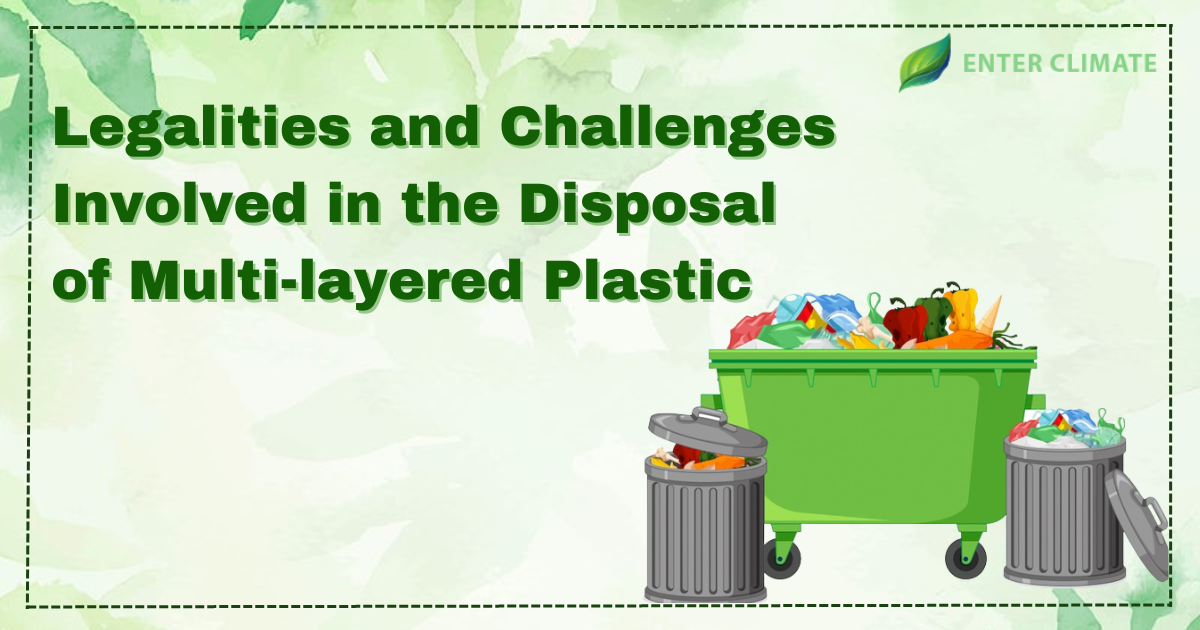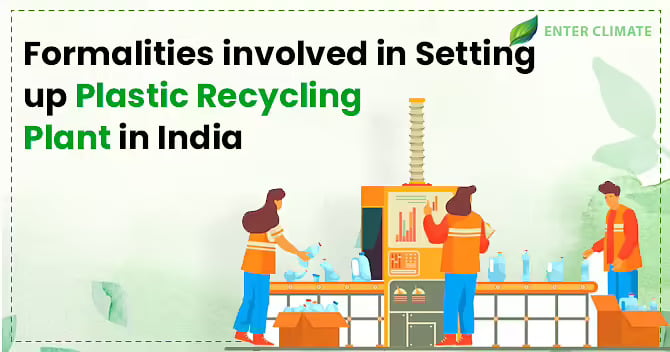Legalities and Challenges Involved in the Disposal of Multi-layered Plastic
 22 Jun, 2023
22 Jun, 2023 
According to a Central Pollution Control Board (CPCB) report, India produces approximately 3.3 million metric tons of plastic waste annually due to. Despite efforts spanning several decades to address plastic pollution, it remains a significant problem with ongoing challenges. One major contributor to this issue is the Disposal of Multi-layered Plastic, which this article focuses on. It explores MLP’s environmental impact and proposes potential solutions to tackle this problem. As per the 2016 rules, MLP is defined as any packaging material that consists of at least one layer of plastic as the primary component, along with one or more layers of materials like paper, paperboard, polymeric material, metalized layers, or aluminium foil, either in the form of a laminate or a co-extruded structure.
Impact of Disposal of Multi-layered Plastic
Around 40 per cent of global plastic waste is produced for packaging purposes, which includes the utilization of MLP in food packaging. It is typically designed for single use. MLP falls under the category of single-use plastics. The food industry favours MLP due to its ability to safeguard food products, extending their shelf life.
Advantages of proper Disposal of Multi-layered Plastic:
- In India’s diverse climate, MLP is highly preferred as it effectively protects food in hot and humid conditions. Consequently, it is extensively used throughout the country.
- Additionally, its lightweight nature and availability in various sizes, from small packets to large ones, make it accessible from small tea stalls to supermarkets.
Disadvantages of improper Disposal of Multi-layered Plastic:
- MLP has become ubiquitous and easy to dispose of but challenging to collect. Consequently, it often becomes litter in landfills or waterways, ultimately entering the food chain.
- Due to its voluminous nature, the practical difficulties in collecting and segregating MLP waste involve labour-intensive processes and limited storage space.
These factors make the economic feasibility of recycling MLP unfavourable, leading to its predominant disposal in landfills. Nevertheless, a few technological interventions have emerged to address this waste management challenge.
Legalities and Challenges in the Elimination/Disposal of Multi-layered Plastic
The concept of gradually eliminating MLPs was initially introduced in the draft Plastic (Manufacture, Usage, and Waste Management) Rules of 2009. Clause 5(f) of this draft highlighted the intention to restrict the use of non-recyclable MLPs. However, when the Plastic Waste (Management and Handling) Rules 2011 were officially implemented, this clause was removed entirely.A renewed attempt to phase out MLPs was made in the Plastic Waste Management Rules of 2016. Clause 9(3) of these rules called for gradually eliminating all multi-layered plastics used in packaging within two years. However, the effectiveness of this provision was significantly weakened by the Plastic Waste Amendment Rules of 2018[1], which introduced additional phrases like “non-energy recoverable” and “alternate use” alongside “non-recyclable.”Nearly 12 years have passed since the idea of restricting the use of MLPs was initially introduced, and unfortunately, progress in this regard has been minimal.
Problems faced during disposal of Multi-layered Plastic
The issue stems from irresponsible human behaviour regarding the Disposal of Multi-layered Plastic. When recycled plastic, it can be transformed into recycled polyester, which can be used to create various items such as shoes, T-shirts, bags, and more. This recycling process helps alleviate the strain on natural resources, giving plastic value. Everyone can contribute by making small changes in their consumption and disposal habits. To start, let’s adhere to these simple yet fundamental guidelines:
- After using any plastic product, rinse it with clean water.
- Crush plastic bottles or containers.
- Keep them separate from wet waste.
- Hand over plastic waste to authorized collectors or recycling agents (Kabadiwalas).
Scope of Extended Producer Responsibility for PIBOs using MLP
The EPR Guidelines have introduced category-specific targets for Producers, Importers & Brand-Owners (PIBOs) in percentages of 25%, 70%, and 100%. Environmental Compensation will be imposed based on the polluter pays principle when PIBOs fail to meet their EPR obligations. This aims to protect and enhance environmental quality while preventing, controlling, and mitigating pollution.
The EPR Guidelines classify plastics into the following categories:
- Category 1: This includes rigid plastic packaging.
- Category 2: It comprises flexible plastic packaging, including single-layer or multilayer packaging, plastic sheets, covers made of plastic sheets, carry bags, plastic sachets, or pouches.
- Category 3: Multi-layered plastic packaging with at least one layer of plastic and at least one layer of non-plastic material falls under this category.
- Category 4: It encompasses plastic sheets and carry bags made of compostable plastics used for packaging.
The Guidelines for the Disposal of Multi-layered Plastic ccover various aspects of MLP plastic packaging, including reuse, recycling, the use of recycled plastic content, and end-of-life disposal. Emphasis is placed on the reuse of rigid plastic packaging to reduce the consumption of fresh plastic materials.
However, suppose an obligated entity utilizes plastic packaging that is 100% biodegradable in the ambient environment, leaving no microplastics, chemical residue, or any adverse environmental and health impacts, as certified by regulatory entities such as the Central Pollution Control Board, Bureau of Indian Standards, or Central Institute of Petrochemicals Engineering & Technology. In that case, the Extended Producer Responsibility target will not apply to such material.
Surplus EPR certificates can be generated to offset the previous year’s targets and obligations. PIBOs can also meet their EPR obligations for a specific category by purchasing surplus EPR certificates from other PIBOs within the same category.
Significance of the EPR Guidelines in MLP Disposal
These guidelines will encourage the development of alternative solutions for the issue of the Disposal of Multi-layered Plastic and provide businesses with a roadmap to adopt sustainable plastic packaging in the following ways:
- They establish a framework to strengthen the circular economy of plastic packaging waste, which relies on principles such as reuse, sharing, repair, refurbishment, remanufacturing, and recycling to create a closed-loop system.
- This approach minimizes resource consumption, waste generation, pollution, and carbon emissions. Taking these steps is crucial for reducing the pollution caused by littered plastic waste in India, where approximately 3.4 million tonnes of plastic waste is generated annually.
- The United Nations Development Programme aims to expand its plastic waste management efforts to 100 cities in India by 2024, highlighting the urgency of addressing this issue.
- The guidelines also introduce the concept of environmental Compensation, which follows the polluter pays principle. Producers, importers, and brand owners who fail to meet their Extended Producer Responsibility (EPR) targets will be liable to pay Compensation. This measure aims to protect and improve environmental quality while preventing, controlling, and mitigating pollution. The polluter pays principle holds individuals responsible for compensating for the damage caused to the environment, irrespective of their intent.
- To ensure the effective implementation of EPR, a committee led by the chairman of the Central Pollution Control Board (CPCB) has been constituted to recommend measures to the Ministry of Environment.
Additionally, State Pollution Control Boards (SPCBs) or Pollution Control Committees (PCCs) are assigned the task of submitting an annual report on the EPR portal, detailing the fulfilment of EPR targets by producers, importers, brand owners, and plastic waste processors in their respective states or Union Territories to the CPCB.
Documents needed for EPR Authorisation for businesses performing disposal of Multi-layered Plastic
- Business Registration/Incorporation Certificate
- Importer Exporter Code
- Factory licence
- GST registration
- No Objection Certificate (CTE, CTO) from SPCB/PCC
- Fire NOC
- Sole proprietor or Authorized Signatory KYC
- Documentary Proof showing sale if conducting business in more than two states (GST/ tax invoice)
- ERP Action Plan for Disposal of MLP Waste
- EPR Action plan
- copy of permission from the relevant Ministry/ Department
- Copy of agreement with dealers, collection centre, recyclers, treatment storage and disposal facilities (if applicable)
- Copy of trade licence issued by Directorate General of Foreign Trade
Potential Solutions for Managing MLP Waste
Energy Recovery: Utilizing MLP in cement factories as an alternative fuel or in Waste-to-Energy (WTE) plants presents a viable solution for reducing plastic waste. These technologies offer the means to efficiently process large volumes of MLP waste regularly.
Conversion of Granules into Products: The recycled plastic granules derived from MLP waste can be effectively employed in injection moulding applications, such as flowerpots, wastebaskets, road dividers, low-cost furniture, park benches, and more. These granules, obtained from MLP, provide manufacturers and producers with numerous benefits. Not only are they sustainable, but they are also more cost-effective than virgin plastic pellets. Utilizing MLP granules promotes a circular economy, thereby mitigating the significant amount of MLP waste that would otherwise end up in landfills, causing harm to the environment.
Pyrolysis: Pyrolysis involves the thermal decomposition of materials at high temperatures within an inert atmosphere. This commonly used technique enables the conversion of plastic waste into energy. The resulting liquid oil produced through pyrolysis can be used as an alternative fuel source, effectively reducing the carbon footprint associated with traditional energy sources.
Benefits of Recycling Multilayer Plastic
Given the growing volume of Disposal of Multi-layered Plastic, recycling emerges as the most effective and sustainable solution for mitigating the environmental impact caused by MLP waste. MLP recycling plays a crucial role in managing the pervasive problem of plastic waste pollution and actively contributes to establishing a circular economy.
By recycling MLP, valuable resources can be recovered and reused, resulting in environmental and economic benefits. Additionally, MLP recycling generates employment opportunities, creating a pathway for formalizing the recycling sector and involving various stakeholders such as ragpickers and recyclers. This approach addresses the challenges posed by MLP waste and fosters a more sustainable and responsible management of plastic waste.
Conclusion
A complete ban on single-use plastic products will not effectively deter manufacturers from producing them. Instead, finding viable substitutes for disposable plastics and creating alternative livelihood opportunities for producers, waste pickers, and other individuals involved in the industry is crucial. Solving the problem of the Disposal of Multi-layered Plastic requires a comprehensive approach. Encouraging citizens to make conscious choices and adopt environmentally friendly habits can have a significant impact. Individuals should actively contribute by refraining from littering, participating in waste segregation, and supporting proper waste management practices. Addressing the issue of single-use plastic requires a multi-faceted approach that involves collaboration between the government, manufacturers, consumers, and other stakeholders. By combining efforts and fostering behavioural changes, we can work towards a more sustainable and responsible approach to plastic usage and waste management. For additional assistance in business-related aspects, it is recommended to take expert advice for the same to comply with the appropriate provisions.
FAQ
Multi-layered Plastic (MLP) is generallyfound in food storage bags and other shelf-stable items; multilayer Plastic keeps things fresh. It is made from different types of plastic that are layered together to ensure that no particles can pass from the environment into the packaged goods.
Most plastics are manufactured for one-time use and cannot be recycled, so they end up in oceans, land etc. This is due to the wrong disposal method of plastics. Plastic waste is finally recycled, incinerated, landfilled, dumped, or littering our environment.
MLPs cannot be recycled due to their complicated structure and presence of non-plastic components, which makes MLPs nearly impossible to recycle, like regular plastic materials such as carry bags and PET bottles.
Multi-Layered plastic is often non-biodegradable and can persist in the environment for hundreds of years due to improper disposal if thrown in landfills, water bodies, or as litter. It causes harm to ecosystems, wildlife, and marine life. Proper disposal helps prevent the accumulation of MLP waste and reduces environmental pollution.
By recycling MLP, valuable resources can be recovered and reused, resulting in environmental and economic benefits. Additionally, MLP recycling generates employment opportunities, creating a pathway for formalizing the recycling sector and involving various stakeholders such as ragpickers and recyclers. This approach addresses the challenges posed by MLP waste and fosters a more sustainable and responsible management of plastic waste.
Read our Article:Post Compliance For Plastic Bag Recycling Business













